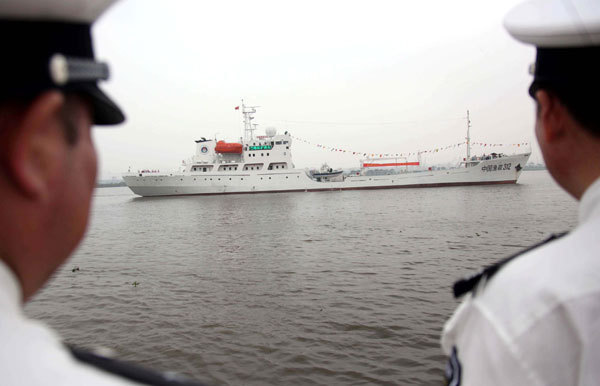China is in dialogue with neighbors regarding South China Sea disputes that arose following the discovery of resources
An important aspect of Chinese military thinking can be illustrated by the teaching of Chinese military strategist Sun Tzu in the Spring and Autumn Period (770 - 476 BC). His teachings state that the supreme art of war is to subdue the opponent without fighting. This speaks volumes for the core value of the Chinese culture represented by the character "he", referring to peace, reconciliation and harmony, which continues to retain significance for today's world.

China’s largest fishery administration ship, the Yuzheng 312, begins its maiden patrol in the South China Sea on Mar 22, 2013. Departing from Guangzhou, it sailed to the Nansha Islands to carry out a law enforcement mission. KE XIAOJUN / CHINA NEWS SERVICE
Today, the Western media often play up the "China Threat", as if it was a great power suddenly emerging out of nowhere. China had long ranked top in terms of naval power, at least before the Ming Dynasty (1368-1644). This can be testified by the seven expeditions made by explorer Zheng He sponsored by the Ming rulers, almost a century ahead of Christopher Columbus's discovery of the "New World".
Rather than bloodshed and colonialism, the most powerful fleet in the world gave porcelain, silk and tea, which brought the Ming Dynasty decades of harmonious relations with its neighbors.
Its isolation from the outside and the corruption of the Qing Dynasty (1644-1911) imperial court, however, led to national backwardness and ensuing suffering at the hands of imperialists, but it has also risen from rubble. Today, the country is determined to pursue a path of peaceful rising and never before has it been so confident in national rejuvenation.
As for the analysis of China returning to the Pacific, it is in fact not analytical at all. China has always been a Pacific country and has never reduced its presence in the region. China is more concerned about peace and stability in the Pacific than any other country and hopes to see a truly "pacific" ocean. Sadly, the landscape is not that harmonious due to recently troubled waters in the South China Sea.
China was the first to discover, develop and exercise effective jurisdiction over islands and reefs in the South China Sea. The country had more than once solemnly reiterated its stand for its maritime rights and interests in the region, before the United Nations Convention on the Law of the Sea came into force in 1994. Beijing issued a statement on its territorial sea in 1958, specifically listing the Nansha and Xisha islands as Chinese territory. Ten days later, then Vietnamese premier Pham Van Dong sent a diplomatic note to his Chinese counterpart Zhou Enlai saying that the Democratic Republic of Vietnam recognized and supported the declaration by the Chinese side.